
Monday, February 6, 2012
Friday, February 3, 2012
How to - Brown Rice
Ahhh, brown rice. Brown rice is one of those foods that gets a bad rap for being “healthy.” I don’t mean healthy in that whole grains are good for you or that it has a lot of fiber as well as important vitamins minerals that are often stripped from white rice. No, I mean it is called “healthy” because when made at home it often doesn’t taste good and it’s only redeeming quality is its health value. Kind of like hearing that your blind date “has a good personality,” describing a food as healthy first has a way of decreasing your expectations for its actual flavor.
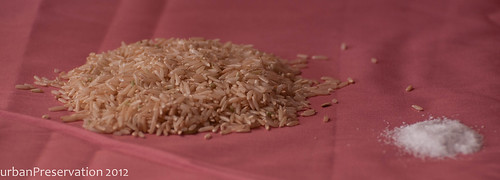
So let’s ignore the fact that brown rice is actually good for you. Brown rice is delicious – it’s nutty and chewy and actually adds something other than starch to your dish. Ok, a lot of brown rice is kind of gummy or crunchy but when it’s cooked well, brown rice can be amazing. Over the years I’ve cooked a lot of slightly under and over cooked brown rice. I’ve even been able to achieve the both over- and undercooked version of brown rice – you know, the one where the rice is both soggy and unpleasantly crunchy?
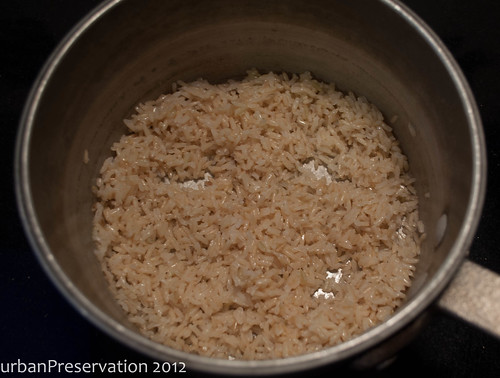
There are lots of recipes out there with varying levels of complexity. But I really think that rice should be easy to make – it should not require multiple techniques or an hour to bring a staggering volume of water to a boil. It should be that think you make to go with the leftovers from last night and it should be on the table within an hour and it should take you no more than 10 minutes of active time. Are you with me?
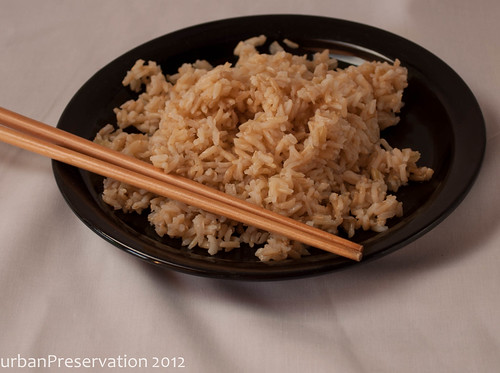
You will need:
Oven-safe medium sized pot with oven=proof lid – you can make a lid out of tinfoil if your lid isn’t oven safe.
1 2/3 or 2 cups water
1 tsp kosher salt – this is key, do not leave it out. Salt helps to mask bitter flavors and enhance sweet and savory ones. The resulting rice will taste better if it’s salted, no matter what method you choose.
1 cup Long grain brown rice – no short or medium grain here, they are too apt to get mushy and while that works in some cases, it’s not what we’re looking for here.
1 tbs olive oil (optional)
How to – baked brown rice
Adapted from How to Cook Everything by Mark Bittman
Step 1. Preheat over to 350F.
Optional Step 1(a). Heat the olive oil in the pot over medium heat. Add the rice and salt and cook for two minutes.
Step 2. Add 2 cups water and bring to a boil.
Step 3. Cover pot and place in oven. Bake for 30 minutes.
Step 4. Remove rice from oven and let sit, covered, for 15 minutes (do not lift the lid until the time is up!)
Step 5. Fluff with a fork and enjoy.
How to – Stovetop* Brown Rice
*I think baked brown rice is superior to stove top since the all-around heat of the oven cooks the rice more evenly and results in rice that is chewy but not crunchy and never soggy. That said, if you still love the ease of the stovetop method, here’s the best way I’ve found to do it.
Step 1. Place the rice in a colander and rinse it thoroughly until the water runs clear and now longer contains starch.
Step 2. Place rice, salt and 1 2/3 cup water in a medium pot and bring to a boil.
Step 3. Cover the pot and turn the heat down to medium low – you still want a very gentle simmer. Set a timer for 30 minutes.
Step 4. While keeping the rice covered turn the heat off and move the pot to a cool burner or to a counter space. Let it sit and steam for 20 minutes. If you lift the lid when it comes out of the oven the rice will look wet, just let it steam and the water will absorb.
Step 5. Fluff with a fork and enjoy.

So let’s ignore the fact that brown rice is actually good for you. Brown rice is delicious – it’s nutty and chewy and actually adds something other than starch to your dish. Ok, a lot of brown rice is kind of gummy or crunchy but when it’s cooked well, brown rice can be amazing. Over the years I’ve cooked a lot of slightly under and over cooked brown rice. I’ve even been able to achieve the both over- and undercooked version of brown rice – you know, the one where the rice is both soggy and unpleasantly crunchy?

There are lots of recipes out there with varying levels of complexity. But I really think that rice should be easy to make – it should not require multiple techniques or an hour to bring a staggering volume of water to a boil. It should be that think you make to go with the leftovers from last night and it should be on the table within an hour and it should take you no more than 10 minutes of active time. Are you with me?

You will need:
Oven-safe medium sized pot with oven=proof lid – you can make a lid out of tinfoil if your lid isn’t oven safe.
1 2/3 or 2 cups water
1 tsp kosher salt – this is key, do not leave it out. Salt helps to mask bitter flavors and enhance sweet and savory ones. The resulting rice will taste better if it’s salted, no matter what method you choose.
1 cup Long grain brown rice – no short or medium grain here, they are too apt to get mushy and while that works in some cases, it’s not what we’re looking for here.
1 tbs olive oil (optional)
How to – baked brown rice
Adapted from How to Cook Everything by Mark Bittman
Step 1. Preheat over to 350F.
Optional Step 1(a). Heat the olive oil in the pot over medium heat. Add the rice and salt and cook for two minutes.
Step 2. Add 2 cups water and bring to a boil.
Step 3. Cover pot and place in oven. Bake for 30 minutes.
Step 4. Remove rice from oven and let sit, covered, for 15 minutes (do not lift the lid until the time is up!)
Step 5. Fluff with a fork and enjoy.
How to – Stovetop* Brown Rice
*I think baked brown rice is superior to stove top since the all-around heat of the oven cooks the rice more evenly and results in rice that is chewy but not crunchy and never soggy. That said, if you still love the ease of the stovetop method, here’s the best way I’ve found to do it.
Step 1. Place the rice in a colander and rinse it thoroughly until the water runs clear and now longer contains starch.
Step 2. Place rice, salt and 1 2/3 cup water in a medium pot and bring to a boil.
Step 3. Cover the pot and turn the heat down to medium low – you still want a very gentle simmer. Set a timer for 30 minutes.
Step 4. While keeping the rice covered turn the heat off and move the pot to a cool burner or to a counter space. Let it sit and steam for 20 minutes. If you lift the lid when it comes out of the oven the rice will look wet, just let it steam and the water will absorb.
Step 5. Fluff with a fork and enjoy.
Thursday, February 2, 2012
Celeriac Gratin
Winter can mean a lot of different things – growing up it meant hot chocolate, sledding, and praying for snow days. Now that I live in Northern California it means intermittent rain, citrus, and running around on the beach (I know, it’s weird here). But despite the differences, winter still means root vegetables – roasted, baked, or made into soups. And for me, root vegetables means celeriac.
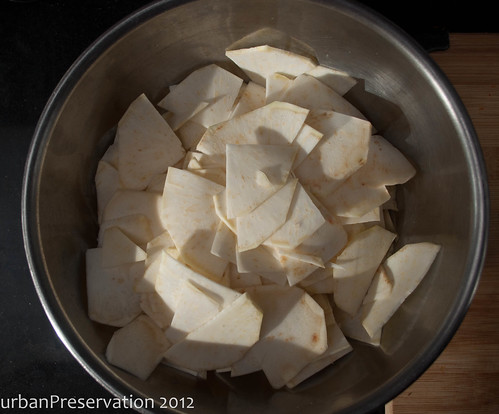
Chances are you have seen celeriac, or celery root, at the grocery store, and then walked right by hoping not to catch its eye. I mean, it’s a big knobby thing with weird root protrusions sticking out all over it and probably large clumps of dirt and perhaps some awkward green shoots coming off the top. It is the awkward teenager of the vegetable world and as a result, is not always well loved. But I love it –and no I’m not just trying to be a hipster here; I want everyone to love it. That ugly exterior is easy to cut away and the flavor is surprisingly crisp, juicy, and fresh. Sort of like celery but without the overwhelming greenness and no threads to pick out of your teeth afterwards. Unlike most root vegetables, celeriac is just as good raw as it is cooked and it’s great in winter salads. And that’s great for those times when you just cannot look at another stick of butter – but I haven’t reached that point just yet.
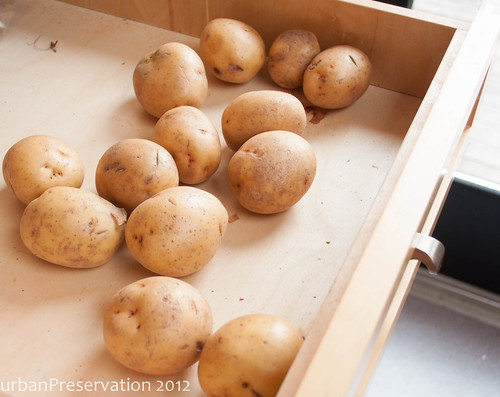
When I think of winter food, I think of hot and filling, stick-to-your-ribs kind of food. And in the vegetable world, that food is gratin. Potatoes are the king of comfort food (or at least in the running) so it seems unfair that they get all the love when it comes to gratin as well. Yes, this gratin has some potatoes too, but the star is really the celeriac. And unlike most gratins it has no cheese. No cheese, you say? Yes, well, it gets along just fine without it thanks. Seriously, I may even prefer this to the traditional cheesy gratin. It’s rich but not dense in the way that a lot of gratins are and as a result it feels just fine to eat two pieces for dinner.
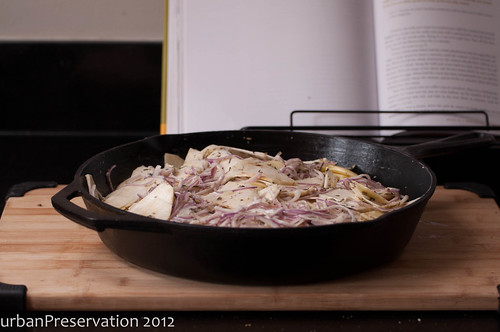
Gratin, like all dishes made of baked vegetables, will turn out best if you make sure to cut all your vegetable pieces to approximately equal widths so they cook evenly. There are two ways to accomplish this: have amazing knife skills or use a mandoline. I took the second route. A year or so ago I bought myself a Benriner mandoline (and some Kevlar gloves to protect my fingers, since I hate that hand guard that comes with it) and I haven’t looked back – it makes meals that much easier to prepare and it takes up very little space in my kitchen.

This gratin is excellent baked in a cast iron pan for extra browning but it would be just as good in a 9 by 13 Pyrex dish. Because it doesn’t have cheese to keep it stuck together, it’s best to cook it ahead of time and reheat it before serving so that it has some time to bind itself together. Or if, like me, you just can’t wait for that first slice, serve it warm from the oven and just a little bit messy.
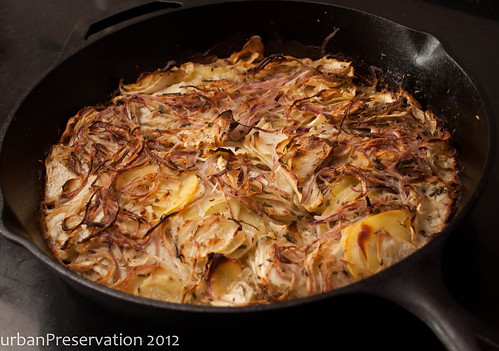
Celeriac Gratin
Inspired by Fennel Gratin in Sunday Suppers at Lucques by Suzanne Goin
1 tbs fennel seeds
1 pound potatoes – preferably Yukon gold or red bliss – I prefer to not peel them and just wash them thoroughly
2/3 cup heavy cream
1 ½ pound celeriac root
1 thinly sliced red onion
1 tbs thyme leaves
1/2 tbs tarragon
1/3 cup olive oil
1 tsp plus 2 tsp kosher salt
Preheat oven to 425F.
Add fennel seeds to a dry pan and place over medium heat. Toast for 2-3 minutes or until seeds are fragrant and barely browned.
Slice the potatoes into 1/16 inch slices - 1/8 if using a knife instead of a mandoline. You may need to halve the potatoes if they’re too big but the resulting slices should be about the same size as the celeriac. Toss the potatoes with cream and 2 tsp salt.*
Cut the ends off the celeriac so it will stand on a cutting board and cut the rest of the outer layer off in strips, working your knife from top to bottom. Quarter the remaining root and slice into approximately 1/16 inch slices (1/8 if using a knife). Add the celeriac slices, fennel seed, thyme, red onion, and olive oil to the potato and cream mixture. Season with 1 tsp salt and mix until well combined.
Grease a 10 inch cast iron skillet or a 9 by 13 Pyrex dish and lined the bottom of the pan with overlapping slices of potato. Arrange the remaining potato and celeriac mixture in the dish.**
Bake the gratin for about 45 minutes, until golden brown in spots and the onions on the top are slightly crispy. Let cool at least 30 minutes before slicing.
*Tossing the potatoes with cream right after they’re cut coats them and prevents them from browning.
** You can choose to artfully arrange all the slices one at a time but I find this tedious. Just lining the bottom will help make it easier to lift out slices and creates some of that tidy pattern without taking as much time.

Chances are you have seen celeriac, or celery root, at the grocery store, and then walked right by hoping not to catch its eye. I mean, it’s a big knobby thing with weird root protrusions sticking out all over it and probably large clumps of dirt and perhaps some awkward green shoots coming off the top. It is the awkward teenager of the vegetable world and as a result, is not always well loved. But I love it –and no I’m not just trying to be a hipster here; I want everyone to love it. That ugly exterior is easy to cut away and the flavor is surprisingly crisp, juicy, and fresh. Sort of like celery but without the overwhelming greenness and no threads to pick out of your teeth afterwards. Unlike most root vegetables, celeriac is just as good raw as it is cooked and it’s great in winter salads. And that’s great for those times when you just cannot look at another stick of butter – but I haven’t reached that point just yet.

When I think of winter food, I think of hot and filling, stick-to-your-ribs kind of food. And in the vegetable world, that food is gratin. Potatoes are the king of comfort food (or at least in the running) so it seems unfair that they get all the love when it comes to gratin as well. Yes, this gratin has some potatoes too, but the star is really the celeriac. And unlike most gratins it has no cheese. No cheese, you say? Yes, well, it gets along just fine without it thanks. Seriously, I may even prefer this to the traditional cheesy gratin. It’s rich but not dense in the way that a lot of gratins are and as a result it feels just fine to eat two pieces for dinner.

Gratin, like all dishes made of baked vegetables, will turn out best if you make sure to cut all your vegetable pieces to approximately equal widths so they cook evenly. There are two ways to accomplish this: have amazing knife skills or use a mandoline. I took the second route. A year or so ago I bought myself a Benriner mandoline (and some Kevlar gloves to protect my fingers, since I hate that hand guard that comes with it) and I haven’t looked back – it makes meals that much easier to prepare and it takes up very little space in my kitchen.

This gratin is excellent baked in a cast iron pan for extra browning but it would be just as good in a 9 by 13 Pyrex dish. Because it doesn’t have cheese to keep it stuck together, it’s best to cook it ahead of time and reheat it before serving so that it has some time to bind itself together. Or if, like me, you just can’t wait for that first slice, serve it warm from the oven and just a little bit messy.

Celeriac Gratin
Inspired by Fennel Gratin in Sunday Suppers at Lucques by Suzanne Goin
1 tbs fennel seeds
1 pound potatoes – preferably Yukon gold or red bliss – I prefer to not peel them and just wash them thoroughly
2/3 cup heavy cream
1 ½ pound celeriac root
1 thinly sliced red onion
1 tbs thyme leaves
1/2 tbs tarragon
1/3 cup olive oil
1 tsp plus 2 tsp kosher salt
Preheat oven to 425F.
Add fennel seeds to a dry pan and place over medium heat. Toast for 2-3 minutes or until seeds are fragrant and barely browned.
Slice the potatoes into 1/16 inch slices - 1/8 if using a knife instead of a mandoline. You may need to halve the potatoes if they’re too big but the resulting slices should be about the same size as the celeriac. Toss the potatoes with cream and 2 tsp salt.*
Cut the ends off the celeriac so it will stand on a cutting board and cut the rest of the outer layer off in strips, working your knife from top to bottom. Quarter the remaining root and slice into approximately 1/16 inch slices (1/8 if using a knife). Add the celeriac slices, fennel seed, thyme, red onion, and olive oil to the potato and cream mixture. Season with 1 tsp salt and mix until well combined.
Grease a 10 inch cast iron skillet or a 9 by 13 Pyrex dish and lined the bottom of the pan with overlapping slices of potato. Arrange the remaining potato and celeriac mixture in the dish.**
Bake the gratin for about 45 minutes, until golden brown in spots and the onions on the top are slightly crispy. Let cool at least 30 minutes before slicing.
*Tossing the potatoes with cream right after they’re cut coats them and prevents them from browning.
** You can choose to artfully arrange all the slices one at a time but I find this tedious. Just lining the bottom will help make it easier to lift out slices and creates some of that tidy pattern without taking as much time.
Wednesday, February 1, 2012
Spinach Uttapam
Sometimes a recipe comes about because I have a specific idea of what I want to make. But more often than not, what I cook is based at least in part on what item in the fridge needs to be used in the next day or two. That was what happened with a bunch of spinach the other day, which I either had to use or lose. When this happens the result is one of two things –the dish is fine but nothing I’ll ever make again and we may or may not eat the leftovers, or it is amazingly delicious and I forget to write down the recipe and I never make it again.
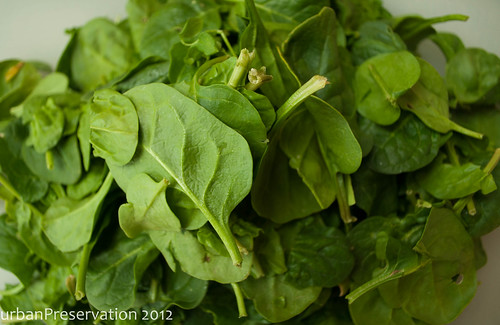
This time, I wrote down the recipe. Then I lost it, then I found it again. You’re welcome.

Uttapam (rhymes with “You da’ bomb” – oooh, sometimes I am so corny I amaze even myself) is a kind of savory pancake that’s common in South Indian cuisine. Never had one? Well most Indian restaurants in the US are Northern Indian but I am lucky enough to live near an excellent South Indian restaurant that specializes in dosa, which are a crepe-style version of the batter used for uttapam. For dosa, the filling is wrapped in the crispy cooked dough but for uttapam, the filling is mixed into the batter, kind of like a savory version of chocolate chip pancakes. Except the uttapam I made used semolina flour which is traditional for rava uttapam, the style I was emulating.
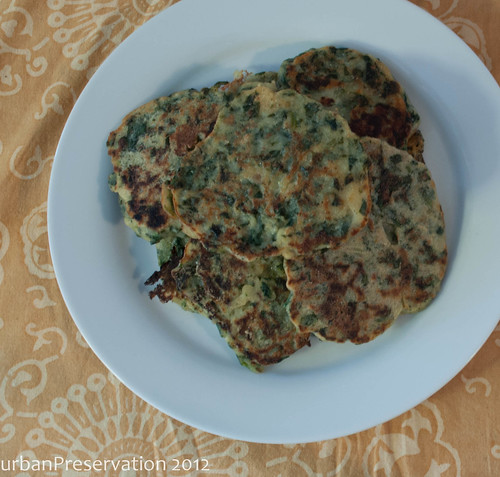
Please make these. I make no promises to their authenticity but to me they taste similar to the ones I’ve ordered in restaurants. And more importantly, they are delicious. When I was testing them I initially made the batter too thick so my roommate and I ate several before calling them a success. She then graciously offered to eat the rest, “You know, if you need any more help figuring out if they’re good.” What a trooper. But seriously, these are no more difficult to make than pancakes and the end result is well worth it. Don’t limit yourself to spinach – what about leftover curry, some chickpea salad, roasted vegetables – just make sure to get out as much liquid as possible before adding the filling to the batter, otherwise it will end up too thin (and in the case of spinach filling it will also turn greenish; not appetizingI ate these for lunch, heated a few in the toaster oven for a snack, and then when I came back to look for them, they were gone. Served with some chutney and yogurt, they have a tendency to disappear fast.
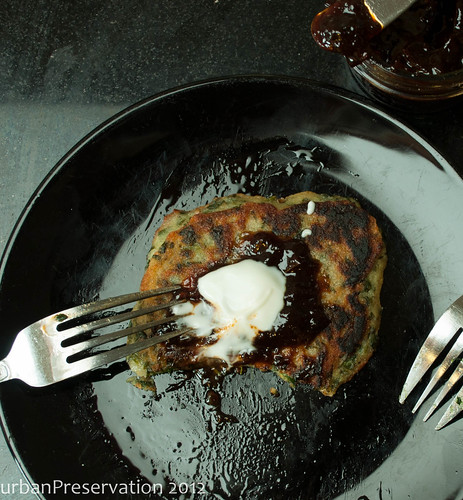
Spinach Uttapam
Makes about a dozen
For the filling:
2 tsp neutral oil
1 tbs fresh ginger, grated
2 cloves garlic, finely chopped
½ lb spinach, fresh or frozen – if frozen make extra sure to squeeze all the liquid out
½ tsp garam masala
1 tsp kosher salt
For the batter:
¾ cup yogurt
½ cup cake flour*
½ tsp each ground cumin, mustard, and coriander
1 tsp fresh ginger, grated
1 ½ cups semolina
2 tsp salt
1 – 1 ½ cups water – depending on what thickness you want
Put the oil, ginger, and garlic in a cold pan and place over medium heat.**Cook for a minute or two, until the garlic is light brown. Add the spinach, salt, and garam masala and cook for three to five minutes, until the spinach is entirely cooked down. If using frozen spinach, cook until some the moisture has evaporated and the ingredients are well mixed. Remove from heat and move spinach mixture to a small-holed strainer. Press the spinach against the side of the strainer to remove as much liquid as possible. Roughly chop the remaining mixture and set aside.
In a larger bowl, mix yogurt, cake flour, spices, ginger, semolina flour, and salt together until well combined. Add 1 cup of water and spinach mixture and stir to incorporate fully. If needed, add up to ½ cup additional water to reach your desired consistency – I like a thinner pancake so I added the full 1 ½ cups.
Heat a pan over medium heat and pour in a few spoonfuls of oil to coat the pan. Fry pancakes until golden brown, about 3-4 minutes a side. Serve warm or at room temperature.
*Uttapam is traditionally made with rice flour, which I didn’t have. Cake flour has a similar gluten content so I used it instead. Feel free to use either
** Using a cold pan and cold oil allows the ginger and garlic to flavor the oil without burning

This time, I wrote down the recipe. Then I lost it, then I found it again. You’re welcome.

Uttapam (rhymes with “You da’ bomb” – oooh, sometimes I am so corny I amaze even myself) is a kind of savory pancake that’s common in South Indian cuisine. Never had one? Well most Indian restaurants in the US are Northern Indian but I am lucky enough to live near an excellent South Indian restaurant that specializes in dosa, which are a crepe-style version of the batter used for uttapam. For dosa, the filling is wrapped in the crispy cooked dough but for uttapam, the filling is mixed into the batter, kind of like a savory version of chocolate chip pancakes. Except the uttapam I made used semolina flour which is traditional for rava uttapam, the style I was emulating.

Please make these. I make no promises to their authenticity but to me they taste similar to the ones I’ve ordered in restaurants. And more importantly, they are delicious. When I was testing them I initially made the batter too thick so my roommate and I ate several before calling them a success. She then graciously offered to eat the rest, “You know, if you need any more help figuring out if they’re good.” What a trooper. But seriously, these are no more difficult to make than pancakes and the end result is well worth it. Don’t limit yourself to spinach – what about leftover curry, some chickpea salad, roasted vegetables – just make sure to get out as much liquid as possible before adding the filling to the batter, otherwise it will end up too thin (and in the case of spinach filling it will also turn greenish; not appetizingI ate these for lunch, heated a few in the toaster oven for a snack, and then when I came back to look for them, they were gone. Served with some chutney and yogurt, they have a tendency to disappear fast.

Spinach Uttapam
Makes about a dozen
For the filling:
2 tsp neutral oil
1 tbs fresh ginger, grated
2 cloves garlic, finely chopped
½ lb spinach, fresh or frozen – if frozen make extra sure to squeeze all the liquid out
½ tsp garam masala
1 tsp kosher salt
For the batter:
¾ cup yogurt
½ cup cake flour*
½ tsp each ground cumin, mustard, and coriander
1 tsp fresh ginger, grated
1 ½ cups semolina
2 tsp salt
1 – 1 ½ cups water – depending on what thickness you want
Put the oil, ginger, and garlic in a cold pan and place over medium heat.**Cook for a minute or two, until the garlic is light brown. Add the spinach, salt, and garam masala and cook for three to five minutes, until the spinach is entirely cooked down. If using frozen spinach, cook until some the moisture has evaporated and the ingredients are well mixed. Remove from heat and move spinach mixture to a small-holed strainer. Press the spinach against the side of the strainer to remove as much liquid as possible. Roughly chop the remaining mixture and set aside.
In a larger bowl, mix yogurt, cake flour, spices, ginger, semolina flour, and salt together until well combined. Add 1 cup of water and spinach mixture and stir to incorporate fully. If needed, add up to ½ cup additional water to reach your desired consistency – I like a thinner pancake so I added the full 1 ½ cups.
Heat a pan over medium heat and pour in a few spoonfuls of oil to coat the pan. Fry pancakes until golden brown, about 3-4 minutes a side. Serve warm or at room temperature.
*Uttapam is traditionally made with rice flour, which I didn’t have. Cake flour has a similar gluten content so I used it instead. Feel free to use either
** Using a cold pan and cold oil allows the ginger and garlic to flavor the oil without burning
Subscribe to:
Posts (Atom)